Virtual reality VR has revolutionized the way stories are told, offering a fully immersive experience that allows audiences not just to observe but to participate. By merging the realms of narrative and technology, VR has the potential to break the boundaries of traditional storytelling, placing the user at the heart of the action. This shift in perspective transforms passive viewers into active participants, allowing them to navigate, explore, and influence the world they are immersed in. The power of VR lies in its ability to transport users into environments that feel tangible and alive. Unlike traditional storytelling mediums such as books, films, or even video games, which guide the audience through a linear narrative, VR opens up the possibility for non-linear, interactive storytelling. In these environments, the user has agency, meaning they can make choices that alter the narrative or shape the outcome of events. This level of immersion creates a unique emotional engagement, as users are not just observing characters’ journeys—they are living them.
Imagine stepping into a fantastical realm, not just as a character in a story but as yourself. You are no longer watching a hero save the day; you are the hero, and the world around you responds to your decisions. This is the promise of interactive storytelling in VR: agency combined with immersion. Through motion tracking and intuitive controls, VR allows users to interact with their surroundings in a natural and intuitive way. You can pick up objects, move through space, and Zero Latency VR engage with characters—giving you a sense of control and presence that is difficult to replicate in any other medium.
One of the most compelling aspects of VR storytelling is its ability to foster empathy. By immersing users in experiences that might be outside their everyday lives—such as stepping into the shoes of someone from a different culture or experiencing a historical event firsthand—VR can provide a powerful emotional connection to stories and perspectives that might otherwise feel distant. Documentaries, for instance, have used VR to take viewers inside refugee camps or war zones, offering an intimate and visceral look at the lives of others, beyond what traditional media could capture. However, with these new opportunities come challenges. Crafting an effective VR narrative requires creators to think differently about pacing, user interaction, and the flow of information. In a world where users can look in any direction or choose their own path, how do you ensure they do not miss important details or moments of the story? As VR continues to evolve, so too will the art of interactive storytelling, pushing the boundaries of how we create and experience narratives. It is a brave new world where the audience becomes the co-author, and the story is shaped by their choices.
